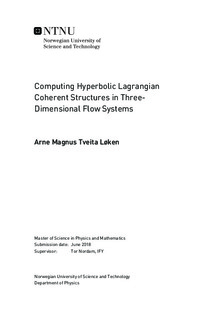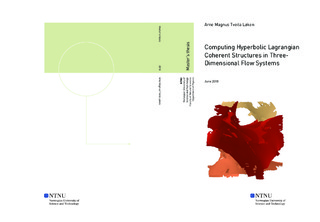| dc.description.abstract | A generic flow system can be described as a system whose state depends on flowing streams of energy, material, or information. Traditional examples of such systems are the transport of properties such as pressure, temperature, and matter in fluids, and the transport of charge in electrical currents. However, valuable insight into various phenomena, including but not limited to algal blooms in the ocean, and crowd patterns formed by humans, can be obtained by regarding them as flow systems.
Lagrangian coherent structures (henceforth abbreviated to LCSs) can be described as landscapes within a multidimensional phase space, which exert a major influence upon the flow patterns in dynamical systems. In terms of predicting future states of complex systems accurately, LCSs provide a simpler means of analysis than the conventional approach of progressively increasing the resoluton of the model(s) involved in numerical simulations. In this context, a complex system is a system which exhibits sensitive dependence on initial conditions. From their variational theory, hyperbolic LCSs are identified as locally most repelling or attracting material surfaces. Somewhat simplified, such surfaces can be considered as generalized trajectories, created by the underlying transport phenomenon. When investigating transport systems, hyperbolic LCSs are of particular interest, as they form the skeleton of observable flow patterns.
Several important, naturally occuring transport phenomena such as the spread of contaminants by oceanic surface currents can reasonably be approximated as planar. This is one possible reason why previous LCS research has mostly been conducted for two-dimensional systems; another may be that the inclusion of a third dimension severely increases the underlying mathematical complexity. To the extent that LCS analysis for three-dimensional flows has hitherto been conducted, a common approach has been to merge a set of two-dimensional projections, resulting in quasi-three-dimensional surfaces. This project is centered around combining the underlying variational principles of hyperbolic LCSs with an acknowledged technique for computing invariant manifolds of vector fields, with a view to developing a robust framework for computing hyperbolic LCSs in three-dimensional flow systems.
Our approach is described in detail, from its theoretical fundament, through how we incorporated the underlying LCS theory into the computation of manifolds and subsequently LCS surfaces, to some clever optimizations regarding computational resource management. Using a few reference cases, we demonstrate the efficacy of our method in reproducing simple three-dimensional manifolds and LCSs. Moreover, the LCSs obtained for a simple, yet chaotic flow system are shown to correspond well with those obtained for a time perturbed version of the same system. This suggests that the computed LCS surfaces are quite robust, and that the unavoidable inaccuracies of model data for simulating transport phenomena need not be a hindrance for applying LCS analysis to real-world systems.
It remains to be seen whether computing truly three-dimensional LCS surfaces yields a sufficient increase in descriptive power, compared to the aforementioned quasi-three-dimensional approach, to warrant the increase in conceptual complexity and computational resource consumption. This balancing act might be context sensitive. | |

